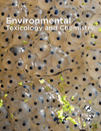Environmental Toxicology and Chemistry 31(10)
Overview of articles on POPs in a new issue of the Environmental Toxicology and Chemistry journal.

Polytopic vector analysis of soil, dust, and serum samples to evaluate exposure sources of PCDD/Fs
pages 2191–2200
Timothy P. Towey, Noémi Barabás, Avery Demond, Alfred Franzblau, David H. Garabrant, Brenda W. Gillespie, James Lepkowski and Peter Adriaens
- As part of the University of Michigan Dioxin Exposure Study, soil, household dust, and serum samples were collected from more than 750 households in five populations around the city of Midland and in Jackson and Calhoun Counties, Michigan, USA. Polytopic vector analysis, a type of receptor model, was applied to better understand the potential sources of polychlorinated dibenzo-p-dioxins and polychlorinated dibenzofurans found in these samples and to quantify the contributions of the sources in each matrix across populations.
Application of a Tenax model to assess bioavailability of PCBs in field sediments
pages 2210–2216
Elizabeth M. Mackenbach, You Jing, Marc A. Mills, Peter F. Landrum and Michael J. Lydy
- Bioavailability has been estimated in the past using equilibrium partitioning-based biota-sediment accumulation factors. These values are not always reliable using field-collected sediments, however, likely due to varying amounts of different organic carbons, particularly black carbon, in sediments. Therefore, improving approaches to better evaluate contaminant bioavailability in sediment are needed. In the present study, a literature-based model was constructed that relied on both laboratory-exposed and field-collected oligochaete bioaccumulation data.
Distribution and sources of polybrominated diphenyl ethers in the Southern California Bight
pages 2239–2245
Nathan G. Dodder, Keith A. Maruya, Gunnar G. Lauenstein, Juan Ramirez, Kerry J. Ritter and Kenneth C. Schiff
- Polybrominated diphenyl ethers (PBDEs) were measured in surface sediments from 121 locations within the Southern California Bight. Site selection was based on a probabilistic approach to determine the spatial extent and magnitude of PBDE concentrations with known confidence intervals. Coastal embayments (including estuaries, marinas, ports, and bays) and the continental shelf out to the lower slope were sampled.
pages 2246–2252
Xilong Wang, Qian Zuo, Yonghong Duan, Wenxin Liu, Jun Cao and Shu Tao
- The spatial variation in concentrations of 16 polycyclic aromatic hydrocarbons (PAHs) in surface soils in the North China Plain and the influential factors were examined in the present study.
Toxic effects of PCB126 and TCDD on shortnose sturgeon and Atlantic sturgeon
pages 2324–2337
R. Christopher Chambers, Dawn D. Davis, Ehren A. Habeck, Nirmal K. Roy and Isaac Wirgin
- Exposure to chemical contaminants is often invoked to explain recruitment failures to populations of sturgeon worldwide, but there is little empirical evidence to support the idea that young sturgeon are sensitive at environmentally relevant concentrations. The authors used shortnose sturgeon (Acipenser brevirostum) and Atlantic sturgeon (Acipenser oxyrinchus) as models to investigate the sensitivities of sturgeon to early-life-stage toxicities from embryonic exposures to graded doses of polychlorinated biphenyl 126 (PCB126) and 2,3,7,8-tetrachlorodibenzo-p-dioxin (TCDD).
18.9.2012




